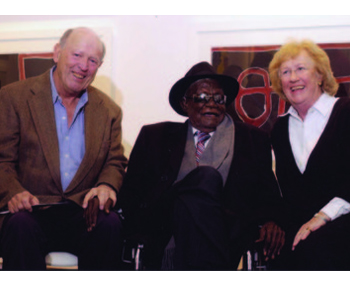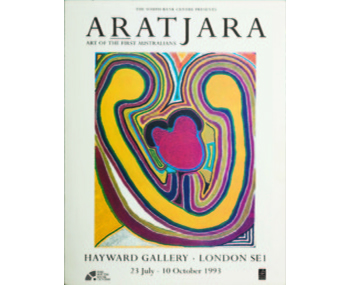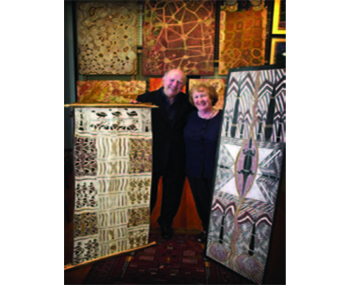COL LAVERTY 26/5/37 to 09/02/13

The late Colin Laverty with his wife Liz and the Jirrawun artist, Paddy Bedford
Jeremy Eccles | 13.02.13
Author: Jeremy Eccles
News source: Obituary
Publication date: 20130214000000
A huge hole has opened up in the Indigenous art collecting world with the death of Dr Colin Laverty OAM at the age of 75. The gentle giant who, in 1978, was the first in the world to publish his findings that the human papillomavirus was linked to cervical cancer, and then found fortune with Laverty Pathology, always had his heart in art as well.
Early on he collected - and wrote about – the gentlemanly tradition of Australian sporting art. But he revealed a daring individuality in the 60s by making the jump to bold gestural abstraction – works by the likes of Tony Tuckson, Peter Upward and Stan Rapotec – which required a confident, refined taste to both appreciate and buy. Later abstract artists who found favour would include Ken Whisson, Ildiko Kovacs and Aida Tomescu.
With his marriage to Liz, though, some figuration crept in. Richard Larter, Bill Robinson, Peter Booth and Noel McKenna entered the picture.
But the team really took off as a couple when they encountered an exhibition of Papunya Tula art during the Brisbane Expo in 1988. We might compare this Damascene event with the great Dreamings show that year in New York which inspired a generation of Americans to begin significant Aboriginal art collections. Coincidentally, art production in remote communities was also flowering. What had begun in the desert – first Papunya in 1971 and then Yuendemu – was beginning to catch fire up the Tanami Track in Balgo and the East Kimberley. Supply and demand, you might say – reflected as well in the opening of specialist commercial galleries like Gabrielle Pizzi's, Utopia and Alcaston House, often by people who'd learnt their skills with the pioneering Aboriginal Arts Australia.
Unlike some collectors of Aboriginal art – perhaps daunted by the distances, the privations of life in remote communities and the complex range of differences between the mindsets of artist and buyer – the Lavertys never shirked visiting the North, where they engaged with the artists and demanded serious consideration from the ever-changing roster of community art co-ordinators. This lead to them buying up to 40 works by some of their favourite artists.
With a Collection that has built to include the works of 426 Indigenous artists - many of them the 'greats' such as Mick Namarari, Sunfly Tjampitjin, John Mawurndjul, Rover Thomas, Emily Kngwarreye and Paddy Bedford – the Lavertys would have had to be taken seriously. But Col, in particular, was on his way to becoming an expert as well. The chapter on Balgo art in the two editions of Beyond Sacred, the book of the Laverty Collection, is thoughtfully penned by him. Many an exhibition of Aboriginal art was opened with his wise words. Selections from the Collection went on tour; works were constantly sought for loan to shows all over the world.
The important London exhibition, Aratjara – Art of the First Australians, featured their Sunfly – Men's Law at Murunpa from 1991 – on the posters for its showing at the Hayward Gallery in 1993.
The Lavertys' was a Collection for the world to share, not to be hoarded. And the two mighty Beyond Sacred tomes were less self-congratulatory than campaigning – both Colin and Liz determined to proselytise their view that they'd not been dabbling in the ethnographic but buying “great contemporary art” on a par with any of their non-Aboriginal art purchases. To help achieve this they recruited academic Howard Morphy – who noted a natural progression from Abstract Expressionism to “the powerful, varied forms of Desert art” - the late curator, Nick Waterlow and the US collector and blogger, Will Owen to riff on that theme. And an exhibition of works from the Collection juxtaposed Tuckson's, Watkins's and Kovacs's work with their Aboriginal objects of passion.
Modest in manner but firm in his opinions, Col Laverty has left us just as a small part of their Collection is being auctioned – at the Museum of Contemporary Art in Sydney on 24 March. The Bonhams catalogue for the sale is a snap-shot of the Lavertys' taste and methodologies. Not a Minnie Pwerle in sight! But definitive pieces by Emily Kngwarreye, John Mawurndjul, Lofty Bardayal, Jan Billycan and Paddy Bedford. And even in a sale, the Lavertys' seem to be making a point. Lot 163 – an exuberant gestural work by Emily of her sacred grasses - is placed right next door to an Untitled Dick Watkins that suggests the same artistic attitude to the meeting of paint and canvas. Sadly, the way of the world, financially, is to be found in the relative pricing of a great Bill Robinson with a great Emily – twice as expensive at half a million dollars. The whole sale could realise $5.57 million.
Twelve Peter Booths reveal him to be the most 'overstocked' artist, with Paddy Bedford not far behind. Lesser known Aboriginal artists who were clearly in favour include Mati Mudjidell and Tjumpo Tjampitjinpa from Balgo, Billy Thomas from Kunanurra and Walangkura Napanangka from Kintore. A lovely Yala Yala Gibbs Tingari story from 1988 would seem to be their first significant purchase - in May 1989; and the collecting hunger was still alive in May 2010 when one of the new APY (female) masters, Tjungkara Ken, caught their eye at Raft Artspace in Alice Springs – a favourite buying haunt when they weren't out bush.
Previews of the sale are being held around the world – from February 14 to 19 at Bonhams in London; from March 2 to 6, Bonhams New York; from March 15 to 17, fortyfive downstairs in Melbourne; and from March 22 to 24 at the MCA, Sydney.
Share this:
»  del.icio.us
»
del.icio.us
»  Digg it
»
Digg it
»  reddit
»
reddit
»  Google
»
Google
»  StumbleUpon
»
StumbleUpon
»  Technorati
»
Technorati
»  Facebook
Facebook
Contact Details

Sunfly Nampitjin's 1991 painting 'Men's Law at Artist's Country at Murunpa' used as the poster image for the 1993 Aratjara Exhibition in London

Col and Liz Laverty amidst their Collection, including the stunning early Emily Kngwarreye - 'Untitled' 1989
Further Research
Artists: Billy Thomas | Emily Kngwarreye | Jan Billycan | John Mawurndjul | Lofty Bardayal | Mati Mudjidell | Mick Namarari | Paddy Bedford | Rover Thomas | Sunfly Tjampitjin | Tjumpo Tjampitjinpa | Tjungkara Ken, | Walangkura Napanangka | Yala Yala Gibbs
News Tags: Bonhams | Col Laverty | Dr Laverty | human papillomavirus | Laverty Pathology | Liz Laverty
News Categories: Australia | Europe | Feature | Industry | North America | OBIT
News Archive
- 11.10.17 | RETURN OF MUNGO MAN
- 10.10.17 | TARNANTHI 2017
- 11.08.17 | Natsiaas 2017
- 08.08.17 | ABORIGINAL ART ECONOMICS
- 02.08.17 | SCHOLL'S NEXT MOVE
- 20.07.17 | APY ART DOMINATES THE WYNNE
- 17.07.17 | Anangu Artist Wins $100,000 Prize
- 14.07.17 | The End of AAMU
- 13.07.17 | YOU ARE HERE
- 11.07.17 | ART ACROSS THE COUNTRY
- 11.07.17 | TARNANTHI IN OCTOBER
- 05.07.17 | TJUNGUṈUTJA - from having come together
- 02.07.17 | BENNELONG
- 27.06.17 | JIMMY CHI
- 23.06.17 | Blak Markets at Barangaroo
Advertising

